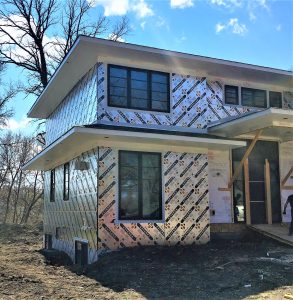
Where Should Halo Interra Be Installed When Insulating a Roof?
Halo Interra should be installed on the underside of the ceiling joists when insulating a roof.
Such placement is ideal because fastening the Interra panels to the joists’ underside is the simplest way to insulate a roof. In contrast, installing the foam boards on top of the joists would be challenging since the slope of the roof would make placement of Interra along the perimeter almost impossible.
The detail below shows the optimal placement of Interra panels in a roof assembly:

That said, in a cathedral ceiling, you’d have to fasten the Interra panels to the undersides of roof rafters.
Keep This In Mind When Insulating a Roof With Interra
Using Interra to insulate a roof is simple. However, these are a few things you should pay special attention to when you fasten Interra beneath the ceiling joists:
- Seal joints and penetrations to the Interra membrane: Interra functions as a code-compliant vapor barrier thanks to its laminate. However, to serve as a vapor barrier, the joints between the Interra panels must be taped. Likewise, you’ll have to tape any penetrations you make in the Interra membrane when you fasten it. In Canada, blue tuck tape is rated as a vapor barrier and is a good option to use.
- Seal Interra to the interior wall membrane: To have a continuous vapor barrier, you’ll have to create a seal between the Interra panels fastened to the ceiling joists and the interior membrane. Either tape or caulking will work in this application.
- Seal the interface between the Interra and the wall membrane in a cathedral ceiling: If you have a cathedral ceiling, you’ll have to fasten the Interra boards to the undersides of the roof rafters. If this is the case, be sure to tape the edges of the Interra boards to the interior membrane along the perimeter.
You can learn more about using Halo’s Interra to insulate ceilings by reading this blog post here.

Don't miss a thing!
Subscribe for exclusive content, insider industry news and limited edition webcasts.









